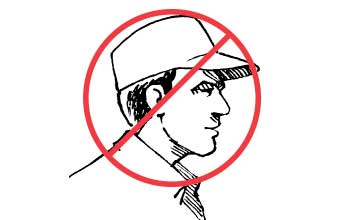Here are some key points.
- The sun’s rays are the strongest between 10 a.m. and 3 p.m.
- Wear sunglasses, sunscreen, a long-sleeved shirt, long pants and a protective hat when you are out in the sun.
- Choose a sunscreen with a sun protection factor (SPF) of 15 or greater.
Too much sun can be dangerous
- Being outdoors on a warm, sunny day can make you feel good.
- But repeated exposure to the sun day after day, year after year also increases your risk of problems.
- Among those problems are:
- aging, wrinkling or drying out of the skin
- skin cancer, which can develop from repeated exposure to the sun over the years
- lip cancer
- damage to the eyes
- Too much exposure to the sun’s ultraviolet rays can harm you, even if you have dark hair and dark skin.
- You can also get sunburned on a cloudy day – not just when the sun is bright.

Use sunscreen lotion on your face, neck, hands, forearms and other unprotected areas of the skin. Be sure to choose a sunscreen with a sun protection factor (SPF) of 15 or greater. The SPF will be listed on the label.

A baseball cap alone won’t adequately protect you from the sun.

Wear a hat that shades your ears, face, temples and the back of your neck from the sun. These come in many styles. Among them are wide-brimmed hats, pith helmets and straw hats with extra wide brims.
Precautions you can take
- Limit the amount of time you spend in the sun. If you work outside all day, take breaks indoors if possible or in the shade.
- Use sunscreen lotion on your face, neck, hands, forearms and other unprotected areas of the skin. Be sure to choose a sunscreen with a sun protection factor (SPF) of 15 or greater. The SPF will be listed on the label.
- Apply the sunscreen before going out in the sun. It’s best to put it on 20 to 30 minutes ahead of time. Then reapply it during the day.
- The sun’s rays are the strongest between the hours of 10 a.m. and 3 p.m. Be especially careful to protect your skin from exposure during those hours.
- Always wear sunglasses to protect your eyes from the harmful rays of the sun. When choosing sunglasses, look for a label that indicates they filter at least 90 percent of the sun’s ultraviolet rays.
Wear the proper protective clothing
- Wear a lightweight, tightly-woven long-sleeved shirt and long pants in the sun. Light-colored cotton clothing is a good choice for hot, sunny days. Be sure your clothes fit comfortably and are not too tight.
- Wear a hat that shades your ears, face, temples and the back of your neck from the sun. These come in many styles. Among them are wide-brimmed hats, pith helmets and straw hats with extra wide brims.
Warning: A baseball cap alone won’t adequately protect you from the sun. If you do wear a baseball cap, wear it with a neck shade. Or look for a baseball-style cap that has a protective sun flap. This will help protect the back of your neck and your ears as well as your face.
How to recognize a problem
- Regularly check your skin for any signs of damage from the sun. Be sure to check your head, face, lips and the tips of your ears.
- Look for changes in the size, shape or color of moles. Specifically look for irregular borders (ragged, notched or blurred edges), moles that aren’t symmetrical (one half doesn’t match the other), colors that aren’t uniform throughout, or moles that are bigger than a pencil eraser.
Also look for:
- sores that bleed and don’t heal
- a change in sensation in a mole, such as itchiness or pain
- red patches or lumps, including small bumps on the head
- new moles
Any of these might be an indication of skin cancer. Skin cancer can be treated if it is caught early. If you spot a problem, see a health professional. Report the problem to your supervisor if you don’t have access to a doctor.
Sun Safety Do’s and Don’ts
Do
- Wear a hat in the sun that protects your ears, face and the back of your neck.
- Choose a sunscreen with a sun protection factor of 15 or greater.
- Regularly check your skin for red patches, lumps, or changes in the size, shape or color of moles.
Don't
- Think that a suntan is a sign of good health.
- Use sunlamps or other artificial means of getting a tan.
- Forget to wear sunglasses to protect your eyes from the sun.
- Be afraid to take immediate action if you think a co-worker is suffering from heat stress.







